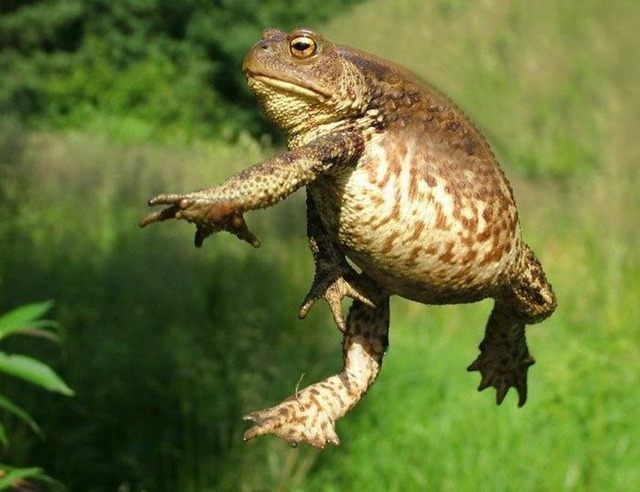With fastly approaching deadlines I have been blogging very little recently, but I have been posting a lot of random links and very short thoughts to my Twitter account (as a former English major, I am, like the New York Times, too proud to use the word verb “tweet” in public). I’ve noticed though that the discussions here tend to be so good that long and in depth ones often develop out of little more than a link, so I am curious, do you – the readers and commenters – think that I (perhaps we) should shed my (our) bias against very short, content-lite blog posts, and put more short posts in this space rather than silly Twitter, on the off chance that it can get some valuable discussion threads going?
Category: Anura (frogs and toads)
Change! ニッポンをカエル
Reports are out that Katsuya Okada will be the foreign minister in Hatoyama’s first cabinet, which is (unfortunately) not nearly as cool as the footnote to the AFP report:
One of [Okada’s] more peculiar hobbies is collecting items that depict frogs. But there is a serious political point — “frog” in Japanese is a homonym for “change” — the slogan used by the DPJ during last month’s election campaign.
This is a fairly popular pun in Japan. Last year I came across this banner at the Akasaka Sacas complex in Tokyo. It says “アカサカカエル、オイシサヲカエル” (Akasaka kaeru, oishisa wo kaeru) which could be read several ways, such as “The Akasaka Frog is changing tastiness,” or perhaps “Change Akasaka and frog the tastiness.”
Legless frogs mystery solved
Interestingly, we have two articles on the link between frogs and pollution, with seemingly contradictory results. First the BBC reports that the spate of deformed frogs with missing limbs, a phenomenon which had always been thought to result from man-made environmental pollution, is actually caused by predatory dragonfly nymphs that actually eat the limb-buds from tadpoles, before they develop proper limbs when they metamorphose into frogs.
And then we have this column from Nicholas Kristof, telling us that It’s Time to Learn From Frogs. And what should we learn exactly? That industrial chemicals used in agriculture or in daily household products such as hairspray act as a weak form of estrogen on the body, causing significant sexual organ deformities in embryos of various species. It is well known that frogs are particularly sensitive to environmental pollution, which is why the aforementioned missing limb phenomenon was long thought to have a chemical trigger, but the evidence is mounting that these sorts of environmental pollution are also causing a stark increase in cases of human sexual organ deformity, particularly among young boys.
I can easily imagine some reactionary “conservative” making a pseudo-scientific argument that because we recently disproved a link between industrial chemicals and missing frog legs, we might as well dismiss the second case out of hand. This would of course be a logical fallacy, as the mechanism is clear and the evidence is plentiful, not to mention relevant so far more animal species than frogs, but don’t be surprised if you see someone trying to make such a claim.
Frogopocalypse strikes Japan
Thousands of frogs were found dead in a pond last fall in Japan’s first confirmed case of the amphibian-destroying ranavirus, a researcher said Friday.
The death of American Bullfrogs occurred in a man-made pond in September and October, said Yumi Une, associate professor of veterinary science at Azabu University in Kanagawa Prefecture.
The dead frogs had symptoms unique to a ranavirus infection, such as bleeding on the surface of the skin and loss or deformity of toes or webs, Une said, adding that the virus was detected in their cells.
Une did not reveal the location of the pond but said more than 10,000 frogs are believed to have died there.
[…]
A new type of ranavirus was found in American Frogs in Taiwan last year, and a gene in the virus found in the dead frogs in Japan resembles one from the virus in Taiwan, Une said.
Doesn’t “American Frogs in Taiwan” sound like the name of a community association or ethnic activist organization? I suppose they’re banding together to lobby for increased government spending on anti-frog plague research.
Another warning sign of the Frogocalpyse
As if the deadly fungal plague wasn’t enough, now they’re being eaten to extinction.
“Frog from Hell”

How could I not point out this BBC report?
A 70-million-year-old fossil of a giant frog has been unearthed in Madagascar by a team of UK and US scientists.
The creature would have been the size of a “squashed beach ball” and weighed about 4kg (9lb), the researchers said.
They added that the fossil, nicknamed Beelzebufo or “frog from hell”, was “strikingly different” from present-day frogs found on the island nation.
A cure for the frogopalypse?
Some good news from New Zealand, scientists may have found a cure for the rampaging fungal plague that has been blamed for the extinction of 40 frog species since 1980 – one third of the 120 species which have gone extinct.
Chloramphenicol, currently used as an eye ointment for humans, may be a lifesaver for the amphibians, they say.
The researchers found frogs bathed in the solution became resistant to the killer disease, chytridiomycosis.
Help is on the way, slimy friends. Now, if only they could figure out a way to prevent whatever it is that eliminated the other 80 species.
Japan creates translucent frog
 Japanese researchers have succeeded in producing see-through frogs, letting them observe organs, blood vessels and eggs under the skin without performing dissections.
Japanese researchers have succeeded in producing see-through frogs, letting them observe organs, blood vessels and eggs under the skin without performing dissections.
Japanese researchers have succeeded in producing see-through frogs, letting them observe organs, blood vessels and eggs under the skin without performing dissections.
“You can see through the skin how organs grow, how cancer starts and develops,” said the lead researcher Masayuki Sumida, professor at the Institute for Amphibian Biology of state-run Hiroshima University.
“You can watch organs of the same frog over its entire life as you don’t have to dissect it. The researcher can also observe how toxins affect bones, livers and other organs at lower costs,” he told AFP.
Mutant Frog Lady with Felt Vomit

Description Stuffed to the brim with wool, very soft and cuddle friendly. Mutant frog lady is a toy perfect for the office cubicle or even a tot(adult supervised of course.)
Ingredients:
wool felt, Barbie limbs, buttons, cotton thread, mohair, wool, Barbie face
This monstrous crime against human and frog kind alike can, tragically, be purchased here.
Panamanian Frogopalypse
 A deadly fungus is sweeping across Cenral America, extinguishing species after species of amphibian. Over 120 species are known to have succumbed so far, and biologists fear that if nothing is done, all remaining species in the region could be annihilated as well. At the moment, a treasured species of golden frog is clinging to existence inside the walls of a “crumbling backpackers’ hangout.” Conservationists, with the support of desperate frog-loving locals, are taking drastic measures to keep their land full of these fragile, colorful, and sometimes mildly translucent creatures.
A deadly fungus is sweeping across Cenral America, extinguishing species after species of amphibian. Over 120 species are known to have succumbed so far, and biologists fear that if nothing is done, all remaining species in the region could be annihilated as well. At the moment, a treasured species of golden frog is clinging to existence inside the walls of a “crumbling backpackers’ hangout.” Conservationists, with the support of desperate frog-loving locals, are taking drastic measures to keep their land full of these fragile, colorful, and sometimes mildly translucent creatures.
With the public quelled, the frog rescue project turned to its next phase: building a state-of-the-art center at a private zoo in El Valle to house the delicate frogs. The nearly completed center will be the ecological equivalent of a nuclear fallout shelter, a refuge from a toxic environment and an uncertain future.
While I imagine most readers will be reminded of Noah’s ark, my first thought when I read this was of the science fiction novel I Am Legend, by Richard Matheson, in which a lone surviving human stays holed up in a fortified building in the middle of a city, fighting off daily attacks by crazed plague-spawn vampires. Hmmm, a community of Brian Jacques style anthropomorphic frogs in a Panamanian rainforest-esque setting, mutated into ravenous beasts by a strange fungus, only one frog left untouched. Or better yet, The Wind in the Willows is in the public domain. It could be a sequel- Toad of Toad Hall, no longer content with puttering around the home countryside in his “magnificent motor-car” decides to go on a grand Central American expedition, but little does he know that in the jungle there lurks an unexpected danger…


